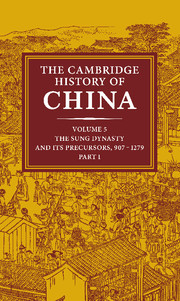Book contents
- Frontmatter
- Introduction: the Sung Dynasty and Its Precursors, 907–1279
- 1 The Five Dynasties
- 2 The Southern Kingdoms between the T’ang and the Sung, 907–979
- 3 Founding and Consolidation of the Sung Dynasty under T’ai-tsu (960–976), T’ai-tsung (976–997), and Chen-tsung (997–1022)
- 4 The Reigns of Jen-tsung (1022–1063) and Ying-tsung (1063–1067)
- 5 Shen-tsung’s Reign and the New Policies of Wang An-shih, 1067–1085
- 6 Che-tsung’s Reign (1085–1100) and the Age of Faction
- 7 The Reigns of Hui-tsung (1100–1126) and Ch’in-tsung (1126–1127) and the Fall of the Northern Sung
- 8 The Move to the South and the Reign of Kao-tsung (1127–1162)
- 9 The Reign of Hsiao-tsung (1162–1189)
- 10 The Reigns of Kuang-tsung (1189–1194) and Ning-tsung (1194–1224)
- 11 The Reign of Li-tsung (1224–1264)
- 12 The Reign of Tu-tsung (1264–1274) and His Successors to 1279
- Bibliography
- Glossary–Index
- References
7 - The Reigns of Hui-tsung (1100–1126) and Ch’in-tsung (1126–1127) and the Fall of the Northern Sung
Published online by Cambridge University Press: 28 March 2010
- Frontmatter
- Introduction: the Sung Dynasty and Its Precursors, 907–1279
- 1 The Five Dynasties
- 2 The Southern Kingdoms between the T’ang and the Sung, 907–979
- 3 Founding and Consolidation of the Sung Dynasty under T’ai-tsu (960–976), T’ai-tsung (976–997), and Chen-tsung (997–1022)
- 4 The Reigns of Jen-tsung (1022–1063) and Ying-tsung (1063–1067)
- 5 Shen-tsung’s Reign and the New Policies of Wang An-shih, 1067–1085
- 6 Che-tsung’s Reign (1085–1100) and the Age of Faction
- 7 The Reigns of Hui-tsung (1100–1126) and Ch’in-tsung (1126–1127) and the Fall of the Northern Sung
- 8 The Move to the South and the Reign of Kao-tsung (1127–1162)
- 9 The Reign of Hsiao-tsung (1162–1189)
- 10 The Reigns of Kuang-tsung (1189–1194) and Ning-tsung (1194–1224)
- 11 The Reign of Li-tsung (1224–1264)
- 12 The Reign of Tu-tsung (1264–1274) and His Successors to 1279
- Bibliography
- Glossary–Index
- References
Summary
approaches and departures: historiographic issues
Ensconced within his palace pleasure gardens, a dissolute aesthete-emperor paints exquisite birds and flowers, even as the empire rots from corruption within and succumbs to invasion from without. Such is the classical historiographic image of Emperor Hui-tsung (1082–1135, r. 1100–26), the penultimate monarch of the Northern Sung. Occupying a tantalizingly ambiguous position in history, he has been simultaneously celebrated as a magnificent patron and practitioner of the arts and reviled as a negligent ruler who nearly doomed the dynasty. For centuries of Chinese historians, Hui-tsung has functioned as a metonymic figure, embodying the contradictions of the Sung dynasty as a whole, symbolizing the ascendancy of wen, the refinements of culture, over wu, the arts of war. Rich in tragedy and irony, the contradictions and contrasts of Hui-tsung’s reign have been suppressed by historians, who have reconstructed a fragmentary corpus of primary sources into a didactic and moralistic narrative.
Judgments of the Hui-tsung era have tended toward high levels of generalization, for the documentary record of his reign poses a minefield of historiographic problems. Foremost of these issues is the moralistic praise-and-blame bias of traditional Chinese historiography. In the standard dynastic histories of the Sung, and in privately compiled works of historiography, Hui-tsung and his long-serving chief councilor Ts’ai Ching (1046–1127) have been held responsible for a litany of crimes against the moral and territorial integrity of the state. Ts’ai and his fellow state councilors, pejoratively referred to as the “Six Felons” (liu tsei), were blamed for prosecuting the most sweeping factional purge in Sung history, allowing governmental corruption to run rampant, and pushing the subjects of the empire toward impoverishment and rebellion.
- Type
- Chapter
- Information
- The Cambridge History of China , pp. 556 - 643Publisher: Cambridge University PressPrint publication year: 2009
References
- 6
- Cited by



